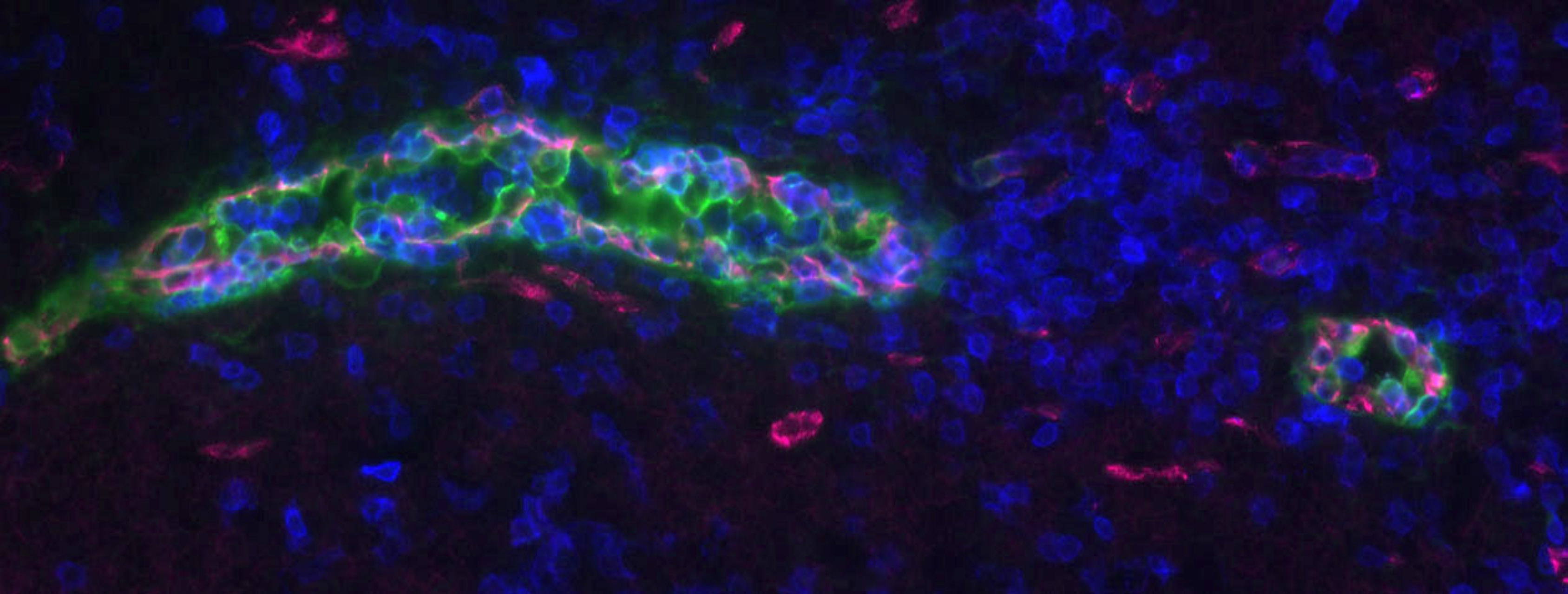VIB researchers identify a new way of supporting and sensitizing immunotherapy in cancer patients
Therapeutic induction of High-Endothelial Venules (HEV) can augment lymphocyte infiltration and contributes to tumor growth inhibition
Ghent/Leuven, 24 November 2022 – Using single-cell transcriptomics, endothelial fate mapping, and functional multiplex immune profiling, the research team led by Gabriele Bergers (VIB-KU Leuven Center for Cancer Biology) has discovered a way to increase lymphocyte infiltration in the tumor microenvironment. By inducing High-Endothelial Venules, the team spearheaded by graduate students Gerlanda Vella and Yichao Hua, was able to transform the protective barrier formed by the tumor vasculature and bypass its defenses against immune cells. The discovery is a big step forward in using novel strategies to increase patient responsiveness to immune therapy.
Immunotherapy, specifically in the form of immune checkpoint blockade (a-CTLA4/a-PD(L)-1), has shown unprecedented benefits in treating cancer patients. ICB treatments work by blocking so-called “immune checkpoint proteins” from binding with their target proteins and helping the body recognize and attack cancer cells. To date, however, a majority of patients does not respond to ICB treatments. Lymphocytes, the immune cells responsible for fending off cancer cells, often cannot infiltrate the tumor well enough due to the immunosuppressive microenvironment of tumors. More specifically, blood vessels formed in the context of tumor growth form a barrier making it almost impossible for lymphocytes to get in range of the cancer cells.
Gabriele Bergers, VIB-KU Leuven Center for Cancer Biology: “In patients where we see a response to ICB therapies, the results are often spectacular. With our research, we wanted to find ways to open up this type of treatment to more patients. To do so, we needed to find a way around the protective barrier formed by the tumor vasculature.”
The team of Gabriele previously pointed out that the presence of Tertiary Lymphoid Like Structures (TLLS) was associated with better therapy response in patients. However, the process behind the formation of such structures remained a mystery. In a research paper that was just published in Cancer Cell, her team now demonstrated how High-Endothelial Venules (HEVs) are induced in the tumor, and that therapeutically inducing HEVs increased lymphocyte infiltration in the tumor, leading to the formation of such TLLS. An important discovery, as it potentially provides a viable pathway to open up ICB treatments to more patients.
The Bergers lab at the VIB-KU Leuven Center for Cancer Biology.

Are new doors opening for ICB therapies?
HEVs, structures typically found in lymph nodes and other secondary lymphoid organs that are responsible for promoting lymphocyte influx, function as a gateway to ensure that lymphocytes get primed and educated before they move around our body and fend off hostile cells. In mouse models of melanoma, colon cancer, and breast cancer the Bergers lab was able to discover that HEVs not only open the way into the tumor, but they also form immune niches containing the progenitor cells responsible for the formation and proliferation of effective T cells.
Gabriele Bergers: “We were delighted to find out that therapeutically inducing HEVs in the tumor vasculature not only facilitated better lymphocyte infiltration in the tumor environment, it also resulted in the creation of niches that expand the immune cells needed to attack the tumor! In a way, you could say that we have identified the Achilles heel of the tumor: the one spot in the tumor vasculature that we can exploit to start taking down cancer cells.”
The discovery offers new perspectives for immunotherapy treatments relying on Immune Checkpoint Blockers and other immunomodulating therapies. In combination with therapeutically-induced HEVs, the patient response to such treatments could potentially be increased, leading to a new way of supporting and sensitizing immunotherapy in patients.
Read the full paper here.
Joran Lauwers
Questions from patients
A breakthrough in research is not the same as a breakthrough in medicine. The realizations of VIB researchers can form the basis of new therapies, but the development path still takes years. This can raise a lot of questions. That is why we ask you to please refer questions in your report or article to the email address that VIB makes available for this purpose: patienteninfo@vib.be. Everyone can submit questions concerning this and other medically-oriented research directly to VIB via this address.
About the VIB-KU Leuven Center for Cancer Biology
Cancer has many causes. Often it is a combination of lifestyle, environmental factors and genetic variation. We need to fight cancer on many fronts, and this can only be done by using knowledge. The researchers of the VIB-KU Leuven Center for Cancer Biology unravel new mechanisms to develop both specific diagnostic methods and treatments.






